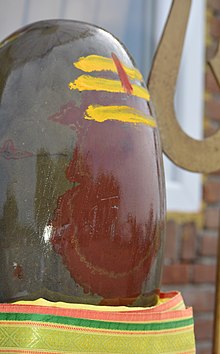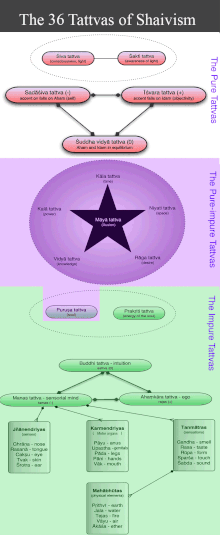Parashiva

| Part of a series on |
| Shaivism |
|---|
 |
| |
Parashiva (or Paramashiva, Paramshiva, or Parmshiva, among other spellings; Sanskrit: परशिव, IAST: Paraśiva)[1] is the highest aspect of Shiva in Shaiva Siddhanta and in Kashmir Shaivism. Below him are the primordial Shiva with the Parashakti and Sadashiva with seven Shaktis.
Shaiva Siddhanta[edit]
According to the Shaiva Siddhanta tradition, which is a major school of Shaivism, Parashiva is absolute reality which is beyond human comprehension and is beyond all attributes. According to Mahamahopadhaya Gopinath Kaviraj, in this aspect Shiva is both formless and with forms. He is beyond both dvaita and advaita.[2][3] In Shaivite theology, Parashiva is both the source and the destination of everything in the existence.
According to the Shaiva Siddhanta tradition, the other two aspects of Shiva are Parashakti and Parameshwara.[4][5][6]
The upper part (oval stone) of Shiva Lingam represents Parashiva while lower part (pedestal) represents Parashakti.[7] Parashiva is beyond all of the 36 tattvas mentioned in Shaivism philosophy.[8]
Kashmir Shaivism[edit]

Kashmiri Shaivism describes how all of reality, with all of its diversity and fluctuation, is the play of the single principle, Paramashiva. The two aspects of this single reality are inseparably united: Shiva and Shakti.[9] Paramashiva appears as the world through his creative power, Shakti. The ontological nature of Paramashiva is beyond human knowledge and articulation, yet it can be experienced directly through mystical intuition.[10]
This section needs expansion. You can help by adding to it. (October 2023) |
See also[edit]
References[edit]
- ^ "Glossary". search for "Paraśiva".
- ^ Dancing with Siva. pp. ŚLOKA 16 (What Is the Nature of Our God Śiva?).
- ^ Dancing with Siva. ŚLOKA 17(https://www.himalayanacademy.com/media/books/dancing-with-siva/web/ch02_02.html).
- ^ "Parashakti".
- ^ "Parameshwara".
- ^ Dancing with Siva. Himalayan Academy. 30 June 2003. search 'परमेश्वर ' and 'पराशक्ति '. ISBN 0945497946.
- ^ "Hinduism for Children". Search for "Śivaliṅga".
- ^ "36 tattva".
- ^ Edward Quinn (2014). Critical Companion to George Orwell. Infobase Publishing. p. 229. ISBN 9781438108735.
- ^ Jagadish Chandra Chatterji (1914). Kashmir Shaivaism. SUNY Press. pp. viii. ISBN 9780887061790.


 French
French Deutsch
Deutsch